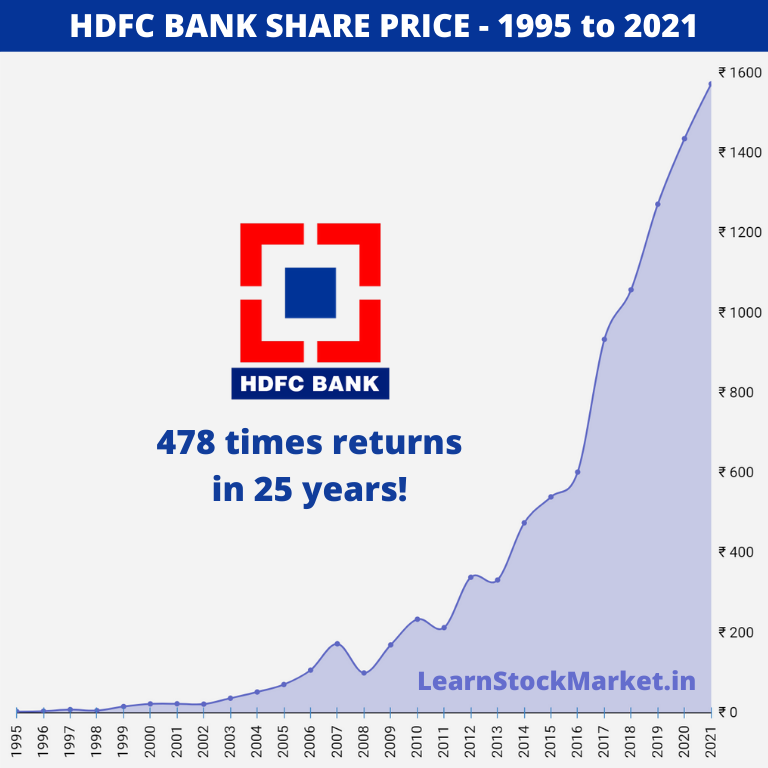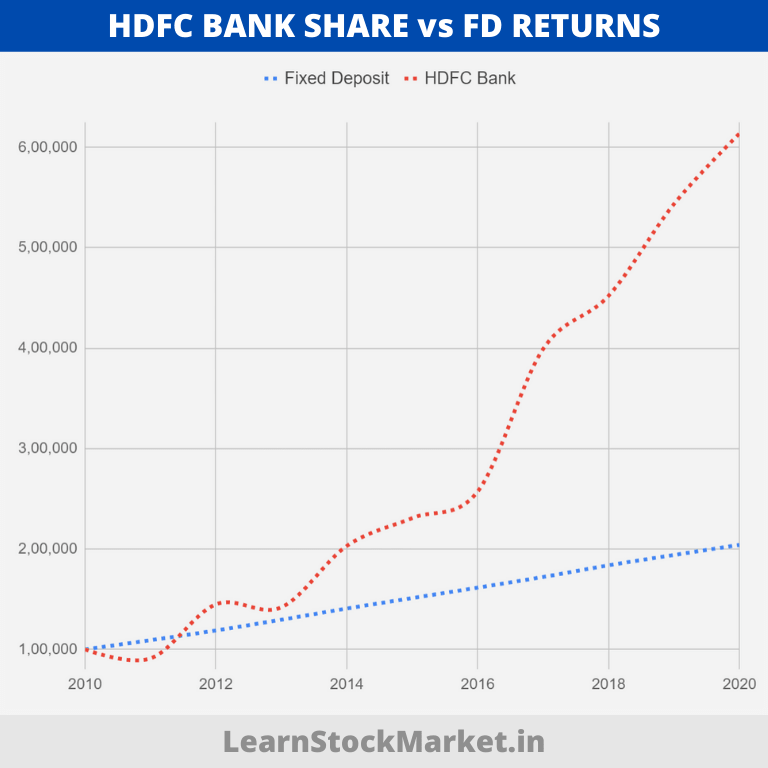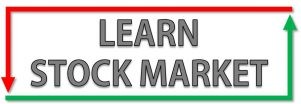HDFC Bank is currently the 3rd most valued company in India. It’s also the biggest private bank in the country.
A bank as successful as HDFC has also created ‘life changing’ wealth for its investors.
- The HDFC Bank share price has gone up more than 500 times, since the year of its IPO in 1995.
- Shares of the company has given significantly higher returns in the last 10-15 years, compared to other asset classes and also fixed deposit in a bank like HDFC.
For a more detailed analysis of the HDFC Bank Share Price, continue reading the article till the end.
HDFC Bank Share Price History

A staggering chart.
When only the ‘year-end’ prices of a stock is taken into consideration, it really helps in removing the daily volatility (up and down movement) of the share price.
It gives a clear picture on how the stock (and also the company) has performed in the last several years and decades.
From the time HDFC Bank established itself as one of the top banks in the country – it has had only two major falls. One was during the financial crisis of 2008, when almost everything across the globe crashed out. And the second was the corona-virus scare which led to panic all over the world, but the recovery was quick.
2010 and 2012 were years of consolidation – but apart from that HDFC Bank has been a steady compounder and a huge wealth creator for its long term investors.
Detailed year-ending share price of HDFC Bank below.
| HDFC Bank | Share Price | Rise / Fall |
| 1995 | 3 | |
| 1996 | 3.9 | 30.00% |
| 1997 | 8 | 105.13% |
| 1998 | 5.5 | -31.25% |
| 1999 | 15.7 | 185.45% |
| 2000 | 22.2 | 41.40% |
| 2001 | 22.5 | 1.35% |
| 2002 | 21.6 | -4.00% |
| 2003 | 36.4 | 68.52% |
| 2004 | 51.9 | 42.58% |
| 2005 | 70.7 | 36.22% |
| 2006 | 106.6 | 50.78% |
| 2007 | 172.5 | 61.82% |
| 2008 | 99.6 | -42.26% |
| 2009 | 169.8 | 70.48% |
| 2010 | 234 | 37.81% |
| 2011 | 213 | -8.97% |
| 2012 | 339 | 59.15% |
| 2013 | 332 | -2.06% |
| 2014 | 475 | 43.07% |
| 2015 | 540 | 13.68% |
| 2016 | 602 | 11.48% |
| 2017 | 934 | 55.15% |
| 2018 | 1058 | 13.28% |
| 2019 | 1272 | 20.23% |
| 2020 | 1436 | 12.89% |
| 2021 | 1573* | 9.54% |
Those are the year-end share prices of HDFC Bank. Go through the table and the graph, and try to form your own opinions on the movement of the share price.
From just ₹ 3 at the end of the year 1995 – when it was first listed at the stock market – HDFC Bank has gone from single digits to a four-digit stock today.
It’s important to note that the share price has been adjusted for share splits – 1:5 in 2011, which means anyone who held 1 share of HDFC Bank got 5 shares of the company. The face value of each share went from ₹ 10 per share to ₹ 2 per share after the split.
In 2019, the shares were split 1:1 once again. Anyone who held 1 share, got one more. The face value went down from ₹ 2 per share to ₹ 1 per share.
In short, if you bought 100 shares of HDFC Bank in the year it was listed (1995), you would have 1000 shares now. The price at the end of its listing year was around ₹ 30 per share, after adjusting for split – it becomes ₹ 3 per share.
From that year, the HDFC Bank share price has gone up more than 500 times – which means, every 1 rupee invested in the company would be worth more than 500 today.
HDFC Bank Share Returns
If you are wondering how much returns ‘HDFC Bank’ has given if you bought the share 2 years ago? Or 3, 4 or 5 years ago.
What if you were holding the shares from 1995?
Check out the table below:
| CAGR | Absolute | |
| 2 years | 16.50% | 1.36 |
| 3 years | 15.42% | 1.54 |
| 4 years | 24.28% | 2.39 |
| 5 years | 21.61% | 2.66 |
| 10 years | 19.89% | 6.14 |
| 15 years | 22.23% | 20.31 |
| 20 years | 23.18% | 64.68 |
| 25 years | 28.00% | 478.67 |
28% compounded annual returns is simply outstanding.
But the number gains even more significance when the absolute returns are considered. 1 rupee invested in HDFC Bank – 25 years ago – would be valued at more than 478 rupees today. That’s 478x ‘multibagger’.
Those who have invested in HDFC Bank over the last few years too have been handsomely rewarded.
1 Lakh invested in HDFC Bank Share
If you had invested 1 lakh in ‘HDFC Bank’, how much returns would it give over different time periods?
The table below has the figures:
| 1 Lakh Invested | |
| 2 years | 1.36 lakhs |
| 3 years | 1.54 lakhs |
| 4 years | 2.39 lakhs |
| 5 years | 2.66 lakhs |
| 10 years | 6.14 lakhs |
| 15 years | 20.31 lakhs |
| 20 years | 64.68 lakhs |
| 25 years | 4.79 crore |
25 years ago, if you were one of those who invested 1 lakh in HDFC Bank and held its share through quarter of a century – your investment would be worth 4.79 crore today.
This does not include dividends, which the company has payed out in the past.
If you held shares of the bank for a decade (10 years), a 1 lakh investment would be valued at 6.14 lakhs.
Do note: Past performance does not guarantee future returns. We do not recommend any stock here, this is for educational purpose only. Kindly consult your financial advisor.
HDFC Bank Share vs FD Returns
What if you opened a fixed deposit of 1 lakh with HDFC Bank and made another investment of 1 lakh in HDFC Bank Shares. Let’s assume both investments were made in the year 2010 (i.e. 10 years ago).
The results are below. The returns from ‘HDFC Bank’ does not include income from dividends.

| Fixed Deposit | HDFC Bank | |
| 2010 | 1,00,000 | 1,00,000 |
| 2011 | 1,09,130 | 91,026 |
| 2012 | 1,18,821 | 1,44,872 |
| 2013 | 1,29,515 | 1,41,880 |
| 2014 | 1,40,692 | 2,02,991 |
| 2015 | 1,51,075 | 2,30,769 |
| 2016 | 1,61,469 | 2,57,265 |
| 2017 | 1,72,093 | 3,99,145 |
| 2018 | 1,83,710 | 4,52,136 |
| 2019 | 1,93,997 | 5,43,589 |
| 2020 | 2,04,027 | 6,13,675 |
| Returns | 7.39% | 19.89% |
Some points:
- The result is clear. A fixed deposit with HDFC Bank would seem like a safer option, but returns from HDFC Bank shares has been significantly higher.
- If an individual investor is willing to invest in riskier asset classes like equity (stocks), his returns can be phenomenal in the long run.
- While the value of the ‘fixed deposit’ was moving steadily in the upward direction, the value of HDFC Bank shares went below its investment for the last 1 year.
- If an investor held-on to the shares for the first one year, he would’ve been rewarded as the share price continued to rise over the last 8 years.
- It’s worth noting that the average fixed deposit interest rates over the last 10 years was 7.39% (RBI data). Currently, the interest rate is much lower. Most banks, including HDFC Bank, is paying between 4-5%.
- For individuals who are in the highest tax bracket, the interest rate after income tax will be much lower.
- Even after 5 years, while shares of HDFC Bank has clearly outperformed the fixed deposit – it’s after 5 years that the power of compounding came into effect and the returns shot up.
Would you invest in HDFC Bank for the future? Are you already a shareholder of the company? What price did you buy it for and when? Tell us in the comments section below.

This is awesome.
Could you share your perspective and analysis on ICICI bank.
Did ICICI Bank also give similar retuns in last 25 years..